The Golden Retriever is one of the largest breeds in the canine family. It is also one of man’s best friends. The Golden Retriever is considered one of the best hunting dogs. They are also beautiful looking dogs.
Contents
Life changes when you have a Golden Retriever. They seem to have a love of life and it is easily passed on to their human counterpart. The Golden Retriever has a broad head on a sturdy body, they are quite muscular for a medium sized breed. The first thing you notice when laying eyes on a Golden Retriever is the dense golden hair.
This breed has a smooth gait, but it is very powerful. He or she will carry it’s tail upright, as a sign of happiness. When you own one of these beautiful dogs, it is not just a big responsibility, it is also a privilege to love a dog with all these attributes.
However, like every animal, even the Golden Retriever has health problems that the owner needs to be aware of. As always, before taking your Golden home, be adamant about having a trained and licensed veterinarian. Getting that first check up with a veterinarian could be the most important step you take that first day.
By visiting the clinic, your veterinarian will get a full exam done of the Golden Retriever that you have chosen to love. They will be sure all shots are up to date, they will check the skeletal frame, the muscular structure, the dental condition and even more. The veterinarian can also inform you of some of the conditions that your beautiful pet is prone to.
He or she will let you know what to watch for, what to be aware of, the types of exercise that your Golden should have daily, even down to the amount and type of food he or she suggests that would be best for your canine.
Other facts of interest when it comes to owning a Golden Retriever, they are eager to please, love outdoor activities, hunting and retrieving, especially in water comes second nature to these beauties. The Golden Retriever is friendly, easy to train and outgoing. Most of all, this gorgeous Golden Retriever is a trustworthy dog.
When it comes to the health of a Golden Retriever, the owner has the responsibility to stay up to date with all aspects. Teeth should be brushed often to prevent dental concerns, full evaluations should be done by a trained professional in regards to the joints, elbows and knees. Exams need to be completed on the heart, the hips and the eyes of a Golden Retriever.
Golden Retriever Common Health Problems
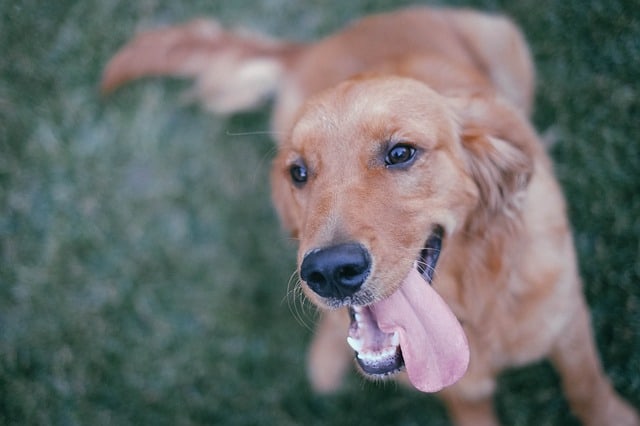
The Golden is prone to juvenile cataracts, heart diseases and the ears need to be checked often for signs of infection. Some of the most common ailments that can happen with your Golden Retriever will include:
- Hip Dysplasia
- Skin Conditions
- Heart and Circulatory Conditions
- Some forms of cancer
- Blood disorders such as Von Willebrand Disease
The most common health issue that can be found within the Golden Retriever breed is Loose Knees. Technically called Luxating Patella, it is exactly what it sounds like. Although not as large as a human knee cap, the kneecap on the Golden can become weakened and then loose and move out of the position it should be in. The kneecap on a Golden Retriever is almond shaped, it will normally sit in a groove in the cartilage. It helps the dog when the knee is extended.
Possible Luxating Patella Signs
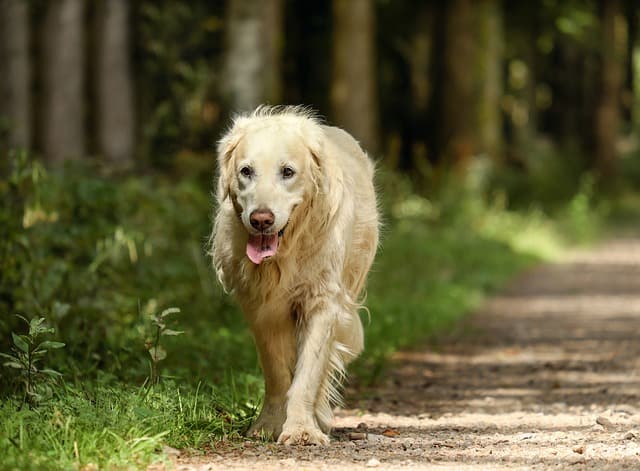
Signs to watch for with Luxating Patella would include:
- Slowing down
- Sitting in an awkward and abnormal position
- Loss of limb support
- Limping
- A Slight skip to the gait
If you were to compare it to a human injury, it is identical to a dislocated kneecap. Humans tend to refer to this as a trick knee, as the kneecap will pop back in. For the Golden Retriever, your gorgeous baby, this will cause pain and that will eventually lead to arthritis.
When a canine is experiencing luxating patella, the abnormal way that they will move will also cause the tibia to rotate differently than the fibula. Together, this stresses the ligament in the knee, called the cranial ligament.
In turn, this can lead to chronic inflammation and pain, and the ligament will wear down over time. The longer, or the more often that the kneecap pops out of that groove in the ligament, the shallower the groove becomes, which means the knee cap tends to pop out more often.
This condition can be genetic, it could be congenital or develop due to a traumatic injury. Most often though, it is genetic. Issues such as skeletal defects such as hip dysplasia, or one of many other possibilities.
Types of Luxating Patella
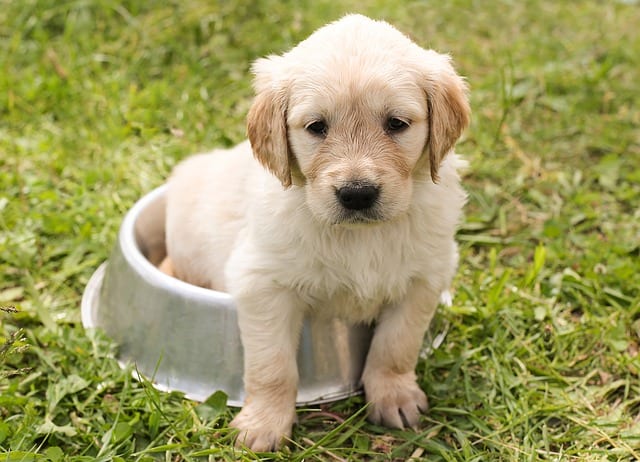
Medial is the most often seen type of luxation in the Golden Retriever. This is when the kneecap rides on the inside of the knee. Medial luxation is an inherited disease. Anatomical abnormalities can cause luxation over time. This is most often seen in the small breeds of dogs, but Goldens will often experience this too. Quite often it will be seen in both hind legs of the dog.
Lateral luxation is the type that will be seen in the medium to large breed dogs. In lateral luxation, the knee cap rides on the outer part of the knee. In the larger breeds, this luxating patella will generally happen after hip dysplasia.
This is due to the abnormal rotation of the femur. That all affects the patellar mechanism. You will also find that roughly half the breeders will state that luxating patella is more common in females Golden Retrievers than it is in males.
Grades of Luxating Patella
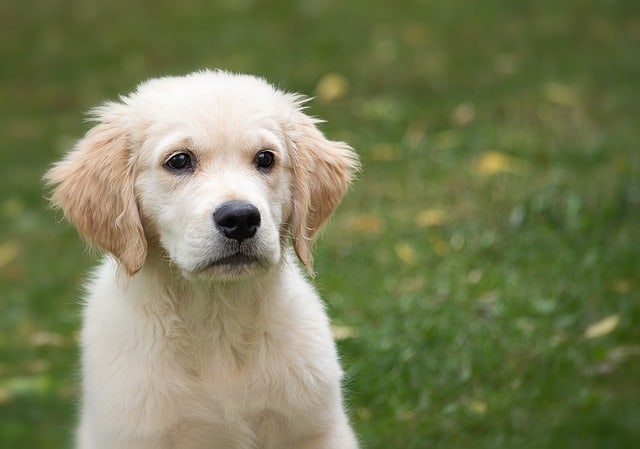
There are four different levels of luxating patella.
Grade 1 is when the kneecap can be moved out of the groove when the knee is extended, but will pop back into place on its own.
Grade 2 is when the kneecap will get out of the groove once in a while, but can be moved back into the groove manually.
Grade 3 the kneecap is consistently out of the groove, riding on either the inside of the knee or the outside. The patella can be placed back into the groove manually, however, it will continue to jump out.
Grade 4 the patella is permanently out of the groove and riding on either the inside of the knee or the outside. At this point, it cannot be moved back into the groove manually.
For some dogs, this condition can start as soon as they begin to walk. These are most often the worst cases, Grade 3 and Grade 4.
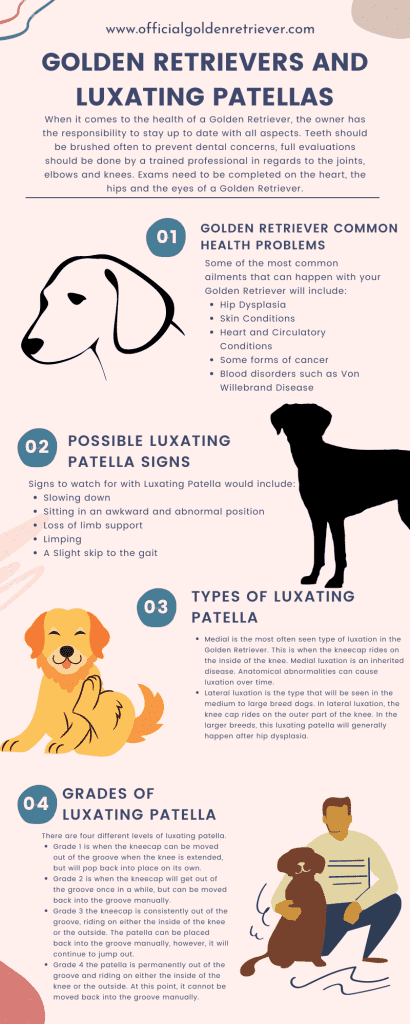
More on the Grading
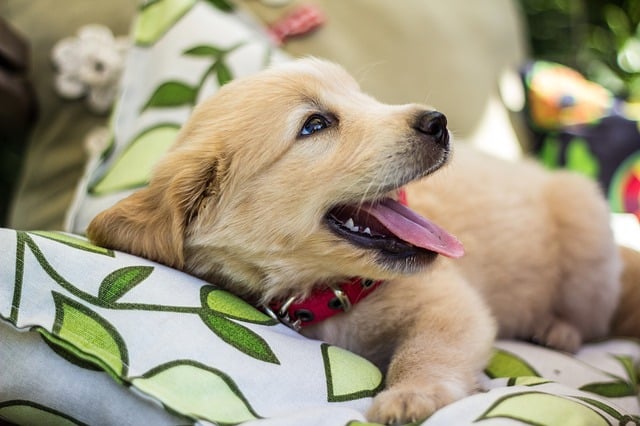
There are some dogs that will have a skip to their gait off and on, but not consistently. These are the lower Grade 1 and Grade 2 cases.
As the dog gets older, there will likely be signs of luxating patella. These would be Grades 1 and 2. This is not always a painful condition for the dogs. If this is a Grade 1 instance, there is not much pain. This can also be managed by exercise and diet for the dog. It is believed that the condition will not increase in severity if diet and exercise is maintained.
The higher grades of this medical issue are painful for the Golden Retriever. As the kneecap continues popping out of the groove, the groove becomes shallower and the patella will continue to pop. This causes more pain for the dog.
Your veterinarian will decide and discuss with you which treatment options are the best for your circumstance with luxating patella in the dog. When it comes to Grades 2 through 4, surgery will be recommended. There are multiple types of surgery that will be discussed with you.
The veterinarian will discuss each in detail so that you have a complete understanding. These surgeries can range from deepening the groove, to reconstruction. Recovery periods vary, however, they should be 3 months or more for a full recovery.
If surgery is not an option due to financial constraints, diet, exercise, vitamins, minerals and supplements may work for a time. Without proper treatment, the luxating patella will only increase in severity and cause more pain for your Golden Retriever or other breed of canine.
A canine Chiropractor may be of some help for your baby, also physical therapy done by a trained professional can also help the dog to be able to move better. The therapist may also be able to show you, as the owner, some forms of therapy that you can do with your Golden Retriever.
Water therapy is also showing promise as to helping maintain proper patella placement. There is the buoyancy aspect as well as the water resistance that helps to build strength.
When you follow guidelines and do what your veterinarian suggests, your Golden Retriever could enjoy a long and healthy life with minimal pain. Golden Retrievers will live on average anywhere from 10 to 13 years of age. By no means, do not refuse to adopt a Golden due to this possible inherited or congenital issue. With the proper care and treatment, you and your best friend will be together for many years.


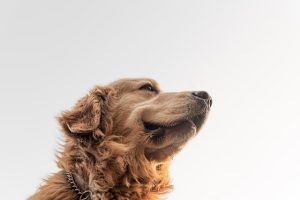
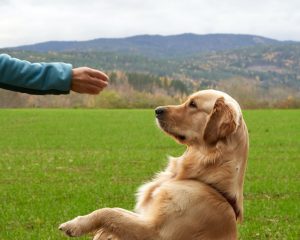

Leave a Reply
You must be logged in to post a comment.